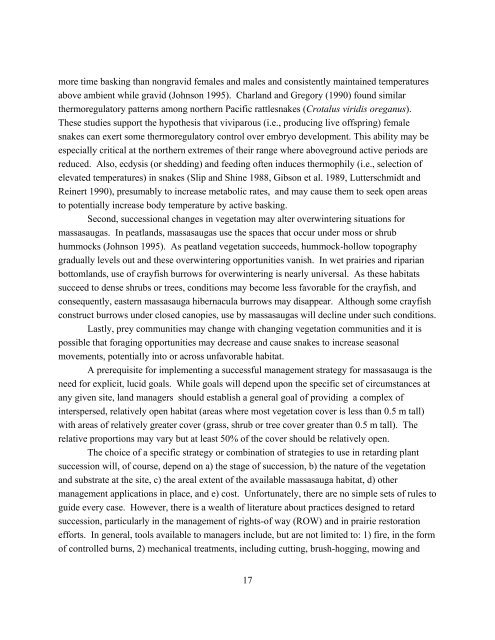The Eastern Massasauga Rattlesnake: - U.S. Fish and Wildlife Service
The Eastern Massasauga Rattlesnake: - U.S. Fish and Wildlife Service
The Eastern Massasauga Rattlesnake: - U.S. Fish and Wildlife Service
Create successful ePaper yourself
Turn your PDF publications into a flip-book with our unique Google optimized e-Paper software.
more time basking than nongravid females <strong>and</strong> males <strong>and</strong> consistently maintained temperatures<br />
above ambient while gravid (Johnson 1995). Charl<strong>and</strong> <strong>and</strong> Gregory (1990) found similar<br />
thermoregulatory patterns among northern Pacific rattlesnakes (Crotalus viridis oreganus).<br />
<strong>The</strong>se studies support the hypothesis that viviparous (i.e., producing live offspring) female<br />
snakes can exert some thermoregulatory control over embryo development. This ability may be<br />
especially critical at the northern extremes of their range where aboveground active periods are<br />
reduced. Also, ecdysis (or shedding) <strong>and</strong> feeding often induces thermophily (i.e., selection of<br />
elevated temperatures) in snakes (Slip <strong>and</strong> Shine 1988, Gibson et al. 1989, Lutterschmidt <strong>and</strong><br />
Reinert 1990), presumably to increase metabolic rates, <strong>and</strong> may cause them to seek open areas<br />
to potentially increase body temperature by active basking.<br />
Second, successional changes in vegetation may alter overwintering situations for<br />
massasaugas. In peatl<strong>and</strong>s, massasaugas use the spaces that occur under moss or shrub<br />
hummocks (Johnson 1995). As peatl<strong>and</strong> vegetation succeeds, hummock-hollow topography<br />
gradually levels out <strong>and</strong> these overwintering opportunities vanish. In wet prairies <strong>and</strong> riparian<br />
bottoml<strong>and</strong>s, use of crayfish burrows for overwintering is nearly universal. As these habitats<br />
succeed to dense shrubs or trees, conditions may become less favorable for the crayfish, <strong>and</strong><br />
consequently, eastern massasauga hibernacula burrows may disappear. Although some crayfish<br />
construct burrows under closed canopies, use by massasaugas will decline under such conditions.<br />
Lastly, prey communities may change with changing vegetation communities <strong>and</strong> it is<br />
possible that foraging opportunities may decrease <strong>and</strong> cause snakes to increase seasonal<br />
movements, potentially into or across unfavorable habitat.<br />
A prerequisite for implementing a successful management strategy for massasauga is the<br />
need for explicit, lucid goals. While goals will depend upon the specific set of circumstances at<br />
any given site, l<strong>and</strong> managers should establish a general goal of providing a complex of<br />
interspersed, relatively open habitat (areas where most vegetation cover is less than 0.5 m tall)<br />
with areas of relatively greater cover (grass, shrub or tree cover greater than 0.5 m tall). <strong>The</strong><br />
relative proportions may vary but at least 50% of the cover should be relatively open.<br />
<strong>The</strong> choice of a specific strategy or combination of strategies to use in retarding plant<br />
succession will, of course, depend on a) the stage of succession, b) the nature of the vegetation<br />
<strong>and</strong> substrate at the site, c) the areal extent of the available massasauga habitat, d) other<br />
management applications in place, <strong>and</strong> e) cost. Unfortunately, there are no simple sets of rules to<br />
guide every case. However, there is a wealth of literature about practices designed to retard<br />
succession, particularly in the management of rights-of way (ROW) <strong>and</strong> in prairie restoration<br />
efforts. In general, tools available to managers include, but are not limited to: 1) fire, in the form<br />
of controlled burns, 2) mechanical treatments, including cutting, brush-hogging, mowing <strong>and</strong><br />
17

















